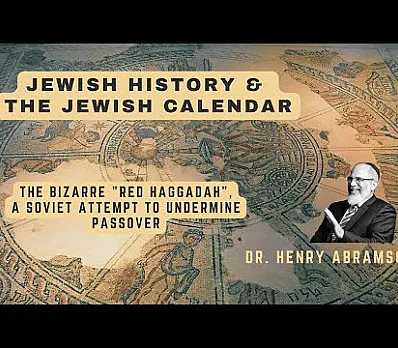Requirements of Eating Matzah
The holiday of Passover has a complex set of rules regarding what may be eaten. Since one is obliged to eat matzah on Passover, it is no surprise that much has been written about matzah, not only when to eat, it but how much must be eaten and who must fulfill this obligation. This article looks at a number of texts dealing with the intricacies of consuming matzah on Passover.
When Is One Obligated to Eat Matzah?
The command to eat matzah appears ten times in the Torah. Nine times the command is for seven days, "Seven days shall you eat matzah" (Exodus 12:15). The tenth time, however, says, "Six days you shall eat unleavened bread" (Deuteronomy 16:8).
A simple and obvious statement of the law (which did not, however, become the accepted practice) is stated by the tanna (rabbi of the Mishnaic era) R. Shimon, originally in the Sifre Deuteronomy (a Tannaitic Midrash):
"Has it not already been said, 'Seven days you shall eat unleavened bread'? Then why does the Torah say 'You shall eat no leavened bread ( hametz ) with it'? When one is obligated to eat matzah, there is also a prohibition against hametz; when there is no obligation to eat matzah, there is no prohibition against hametz" (Bavli Pesachim 28b, cf. Sifre Deuteronomy 130).
The obligation to eat matzah and the prohibition against hametz are co-extensive. Since the prohibition against hametz is clearly for seven days, the obligation to eat matzah, according to Rabbi Shimon, also lasts seven days. This is also the approach of the apocryphal book of Jubilees, and is also the custom of the Karaites and the Samaritans, groups that broke off from the main body of the people of Israel. The most common rabbinic interpretation of the verse from Deuteronomy that prescribes six days rejects this early understanding:
"One verse says, 'Seven days you shall eat matzah,' and one verse says, 'Six days you shall eat matzah.' How can both of these verses be maintained? The seventh day was included (in the first verse) but then excluded (from the second verse). That which is excluded from a more inclusive statement is meant to teach us about the whole statement. So, just as on the seventh day it is optional ( r'shut ), so all the other days, it is optional. Does this mean that it is optional on the first night too? The verse 'In the first month, on the fourteenth day in the evening, you shall eat matzah' (Exodus 12:18) fixes it as an obligation ( hovah ) to eat matzah on the first night" (Mekhilta, Pischa 8).
According to this midrash, Deuteronomy refers to the first six days, and accordingly, the seventh day of the holiday has no obligation to eat matzah. But since there is no essential difference between the seventh day and any of the other days, the rabbis argue, what is true of the seventh day must be true of all of the days. Therefore, there is no general obligation to eat matzah throughout the holiday. On the other hand, the explicit verse from Exodus 12:18 does create a requirement to eat matzah on the first night. Outside of the land of Israel, Jews who observe two days of the holiday are rabbinically obligated to eat matzah at each of the seders, but not on the other days of the festival.
How Much Matzah is One Supposed to Eat?
During the seder, one makes two different blessings over the matzah. The first blessing is hamotzi ("…who brings forth bread from the earth"), which is recited whenever one eats bread, and which is obligatory at any festival meal. The second blessing recalls the particular obligation to eat matzah ("…who has sanctified us with the commandments and commanded us concerning the eating of matzah"). In general, when one is obligated to eat something, the standard amount is a volume equivalent to that of an olive, a k'zayit.
How should one fulfill this obligation to eat matzah? Hamotzi on other festivals is usually said on a whole loaf of challah, so on Passover should one eat the olive's-bulk of matzah from the top of the three matzot on the seder plate, which is still whole and is therefore analogous to a loaf? Or should one eat from the middle, broken matzah for the fulfillment of the obligation to eat matzah?
Joseph Karo writing in the standard code of Jewish law, the Shulhan Arukh, predictably requires a bulk of matzah equivalent to two olives:
"One washes one's hands and makes the blessing and takes the matzot... in hand and makes the blessings 'hamotzi' and 'on eating matzah.' Then one breaks from the top, complete matzah and the broken middle piece, both together... One eats an olive's bulk from each of them while reclining. If one cannot eat matzah equivalent to the bulk of two olives together, eat the one for hamotzi first and then the one [for the blessing] on eating matzah. Then one takes an olive's bulk of bitter herbs... and makes the blessing on eating bitter herbs and eats it without reclining. Then one takes the third matzah and breaks a piece from it to wrap with the bitter herbs" (Shulhan Arukh Orah Hayyim 475:1).
Modern authorities have debated whether the air pockets in matzah count toward measuring an olive's bulk, and most say that they do not. They also have debated about whether an olive's bulk is really the size of a modern olive, or whether it is actually the bulk of an egg. That makes a single "olive's bulk" equivalent to approximately two-thirds of a standard, machine-made matzah or the area equivalent to an average adult hand of hand-made matzah. In addition, modern authorities also define a time limit within which one should, ideally, consume the matzah.
Is All Matzah the Same?
In order for dough to become matzah, it must at least have the potential to leaven. According to the rabbis, leavening ( himutz ) only occurs when flour from the five grains (wheat, oats, barley, rye, or spelt) is moistened with water (by their definition). Flour that is moistened with wine, oil, honey, eggs, or fruit juice does not leaven; the fermentation that occurs is called sirchon (rotting). Despite the negative category name, sirchon is different leavening, which is the category with which the Passover prohibitions are concerned.
Therefore, the matzah-like product made with flour and apple juice that is called "egg matzah" or matzah ashirah (rich matzah) is not subject to leavening, just "rotting," and is theoretically acceptable for Passover use. Widespread custom, however, rejected its use. The Ashkenazic (East European) authority, R. Moses Isserles (known as the Rema), however, is wary of this permission and gives the custom legal force:
"Eggs and other liquids are all considered like fruit juice (which lead to rotting, not leavening). Rema: But in our communities, we do not knead (matzah) dough with fruit juice... And one should not change from this unless in a time of emergency for the sake of a sick or old person who needs this" (Shulhan Arukh Orah Hayyim 462:4).
The Ashkenazic restrictions on use of "egg matzah" are usually printed on the box. Even according to Sephardic (Mediterranean) practice, however, one cannot fulfill the obligation to eat matzah at seder with "egg matzah." First, the obligation must be fulfilled with real matzah, and real matzah must have the potential to leaven, which egg matzah does not. Second, the command is to eat "matzah, the bread of poverty" (Deuteronomy 16:3) and not egg matzah, which is also known as rich matzah.
An additional concern comes from the Torah's command, "You shall watch the matzot" (Exodus 12:17). This is understood by the midrash as "watch it so that it does not become unfit" (Mekhilta Pischa 9), that is, it should not be allowed to leaven. When one begins to watch the dough is a matter of some controversy. The earliest sources assume that the watching begins with the kneading of the dough. The common practice today is to watch the flour from time it is ground. Most commercial matzah is watched from the time of grinding.
The most strict approach, however, is to watch the grain itself from the time it is harvested.
"[Rava] said to those who were turning over the sheaves of wheat (during the harvest): 'When you flip them over, do so for the sake of the mitzvah.' From this we can reason that watching is required initially from the beginning to the end" (Bavli Pesachim 40a).
Matzah made from flour ground from grain which has been watched since harvest is called shemurah matzah (watched matzah). Many Jews choose to use shemurah matzah, especially hand-made shemurah matzah, for fulfillment of the obligation to eat matzah at the seder.
Who is Obligated to Eat Matzah?
The eating of matzah is a positive commandment (as opposed to not eating hametz, which is a negative commandment) that takes place at a specific time. There is a general rule in talmudic literature that women are exempt from positive commandments that take place at a specific time (Mishnah Kiddushin 1:7). Indeed, women are exempt from reciting the shema, wearing tefillin (both in Mishnah Berakhot 3:3), sitting in the sukkah (Mishnah Sukkah 2:8), shaking the lulav, blowing the shofar, and wearing tzitzit (all three in Bavli Kiddushin 33b).
On the other hand, women are obligated to observe other positive, time-specified commandments such as fasting on Yom Kippur (Bavli Sukkah 28a), lighting Hanukkah candles (Bavli Shabbat 23a), reciting the megillah on Purim (Bavli Megillah 4a), and eating three meals on Shabbat (Rabbenu Nissim on Shabbat 44a). Based on the association of not eating hametz with the positive command of eating matzah (akin to the midrash of Rabbi Shimon, above), women are also obligated to eat matzah at the seders (Bavli Pesachim 43b). For that matter, women are also obligated to drink the four cups of wine (Bavli Pesachim 108a-b), to recite the Haggadah, and to chant the Hallel (psalms of praise) at the seder (Mishnah Berurah 472:14).
Inspired to create
your own Haggadah?
Make your own Haggadah and share with other Seder lovers around the world
Have an idea
for a clip?
People like you bring their creativity to Haggadot.com when they share their ideas in a clip
Support Us
with your donation
Help us build moments of meaning and connection through
home-based Jewish rituals.
OUR TOP CONTRIBUTORS
Passover Guide
Hosting your first Passover Seder? Not sure what food to serve? Curious to
know more about the holiday? Explore our Passover 101 Guide for answers
to all of your questions.






















